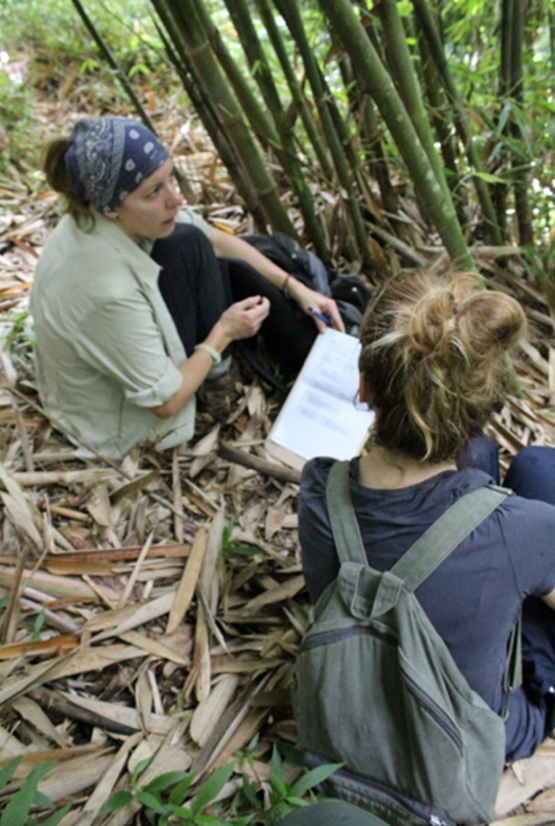April 12, 2023
UCalgary anthropologist studies evolution of human sleep patterns

It was while completing her PhD in anthropology and geography, doing fieldwork on the Indonesian island of Java, that Dr. Kathleen Reinhardt conducted the first-ever sleep study of nocturnal primates in the wild. Her observations shifted her research trajectory and she broadened her lens to incorporate human primates into her years-long work on primate sleep patterns.

Daytime sleeping site data collection.
Kathleen Reinhardt
What got Reinhardt contemplating human sleep patterns after years of intensive research on primate physiology? It was when she became aware that the slow Ioris, a Javan primate that is a close cousin of the lemurs, nap, just like humans.
This shift in focus is what led Reinhardt — who earned her PhD at England’s Oxford Brookes University — to the University of Calgary where, as a postdoctoral fellow in transdisciplinary research, she has set about researching the evolution of human sleep patterns in relation to changes in the environment. Her supervisor is Dr. Vivek Venkataraman, PhD, an assistant professor in the Department of Anthropology and Archaeology who runs the Human Evolutionary Ecology and Energetics Lab. Her co-supervisor is Department of Psychology professor Dr. Michael Antle, PhD, one of North America’s leading experts on human sleep patterns and circadian rhythms.
“We found that ambient temperature played a major role in shaping the daily sleep patterns of the Javan slow Iorises, and that they take naps when they’ve had disruptions in their sleep due to temperature shifts,” Reinhardt says. “I began to wonder if humans are similarly affected by changes in their environment.”
But changes in the human environment go far beyond temperature shifts. Reinhardt is now focusing on environmental and lifestyle changes that occurred for humans as they made the shift from small-scale to industrialized societies.
“This brought about a huge range of environmental buffers,” Reinhardt explains. “Think about going from a thatched house to a concrete building. Or, the introduction of artificial lighting, which often leads led to people staying up later, with a shorter duration of sleep.”

Kathleen Reinhardt has often used her art to illustrate her scientific research. As a scientific illustrator, she has often incorporated her art into scientific publications and as a means of species identification.
Kathleen Reinhardt
This summer Reinhardt will be doing fieldwork in Malaysia, joining Venkataraman’s Orang Asli Health and Lifeways Project — a long-standing research project examining how lifestyle changes influence health among the Indigenous Orang Asli. Reinhardt will be studying the sleep habits of the Orang Asli.
Reinhardt will be doing a cross-cultural analysis, comparing various sub-ethnic groups of the Orang Asli, including the Temiar — traditional, small-scale horticulturalists — and the Batek — traditional hunter gatherers. These groups are undergoing the shift from a traditional lifestyle to industrialized in stages that vary.
“As these small-scale societies are becoming more acculturated, they’re undergoing transitions that we’ve seen in other human societies,” Reinhardt explains. “It’s the perfect environment to study how these lifestyle changes impact sleep patterns.
"So far, we’ve found that the group with electricity has more flexible sleep patterns, going to bed later, but still waking up at the same time as the other group to perform daily activities. So, they’re showing a much shorter duration of sleep and circadian disruption.”
Reinhardt is also doing research closer to home, having started a pilot study in Calgary wherein she’ll be working with outdoor athletes. “If you look at industrialized societies, our sleep environments are all pretty homogenous,” she notes. “The vast majority of us sleep in buildings which provide a certain environmental buffer.
"To examine a fuller range in our industrialized society, I needed to work around that homogenous lifestyle, and these semi-nomadic outdoor athletes seemed ideal. They’re trekking and mountaineering all day, sleeping outside. My goal is to find out how they’re adapting to these environmental exposures after all that physical activity. How does this affect their sleep patterns and sleep homeostasis?”

Kathleen Reinhardt is researching the evolution of human sleep patterns.
Nada Hassanin
Reinhardt’s research on the evolution of human sleep patterns is especially relevant today. “We’re facing a huge sleep epidemic in industrialized societies and that has many implications for our health,” she says. “Sleep regulates everything — our hormones and metabolism, our memory consolidation. The lack of sleep has been linked to metabolic diseases.”
Notably, these issues are not nearly as prominent in small-scale societies. By doing a cross-analysis of small-scale versus industrialized societies, Reinhardt seeks to pinpoint the variables that are making the largest impacts on modern sleep patterns.
“There’s this idea today that to have a better sleep we need to have the most comfortable bed, the ergonomic pillows; temperature regulated sheets are the latest thing. But none of this is true to how sleep would have evolved,” Reinhardt says. “Despite all these sleep aids, the fact is we have this epidemic happening in our industrial society. There must be factors at play that we’re not seeing or understanding.”






